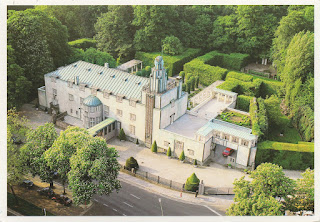During our holidays in Salzburg we took one day to visit Hallstatt and besides the cold, that made us buy there some winter clothes, it was very worth it because it's a beautiful village!
 |
| Hallstatt |
Hallstatt is known for its production of salt, dating back to prehistoric times, and gave its name to the Hallstatt culture, a culture often linked to Celtic, Proto-Celtic, and pre-Illyrian peoples in Early Iron Age Europe, c.800–450 BC. Some of the earliest archaeological evidence for the Celts was found in Hallstatt. - in: wikipedia
 |
| Hallstatt |
The Hallstatt-Dachstein alpine landscape, part of the Salzkammergut, and thus of the Eastern Alps, is one of visual drama with huge mountains rising abruptly form narrow valleys. Its prosperity since mediaeval times has been based on salt mining, focused on the town of Hallstatt, a name meaning salt settlement that testifies to its primary function.
 |
| Hallstatt |
Systematic salt production was being carried out in the region as early as the Middle Bronze Age, (the late 2nd millennium BC), when natural brine was captured in vessels and evaporated. Underground mining for salt began at the end of the late Bronze Age and resumed in the 8th century BC when archaeological evidence shows a flourishing, stratified and highly organised Iron Age society with wide trade links across Europe and now known as the Hallstatt Culture. Salt mining continued in Roman times and was then revived in the 14th century. The large amounts of timber needed for the mines and for evaporating the salt where extracted from the extensive upland forests, which since the 16th century were controlled and managed directly by the Austrian Crown. The Town of Hallstatt was re-built in late Baroque style after a fire in 1750 destroyed the timber buildings.
 |
| Hallstatt |
The beauty of the alpine landscape, with its higher pastures used for the summer grazing of sheep and cattle since prehistoric times as part of the process of transhumance, which still today gives the valley communities rights of access to specific grazing areas, was 'discovered' in the early 19th century by writers, such as Adalbert Stifler, novelist, and the dramatic poet Franz Grillparzer, and most of the leading paintings of the Biedermeier school. They were in turn followed by tourists and this led to the development of hotels and brine baths for visitors.
 |
| Hallstatt |
The landscape is exceptional as a complex of great scientific interest and immense natural power that has played a vital role in human history reflected in the impact of farmer-miners over millennia, in the way mining has transformed the interior of the mountain and through the artists and writers that conveyed its harmony and beauty. - in: http://whc.unesco.org/en/list/806
 |
| Dachstein |
This postcard was sent by Anna
Hoher Dachstein is a strongly karstic Austrian mountain, and the second highest mountain in the Northern Limestone Alps. It is situated at the border of Upper Austria and Styria in central Austria, and is the highest point in each of those states. Parts of the massif also lie in the state of Salzburg, leading to the mountain being referred to as the Drei-Länder-Berg ("three-state mountain"). The Dachstein massif covers an area of around 20×30 km with dozens of peaks above 2,500 m, the highest of which are in the southern and south-western areas. Seen from the north, the Dachstein massif is dominated by the glaciers with the rocky summits rising beyond them. By contrast, to the south, the mountain drops almost vertically to the valley floor. - in: wikipedia














































